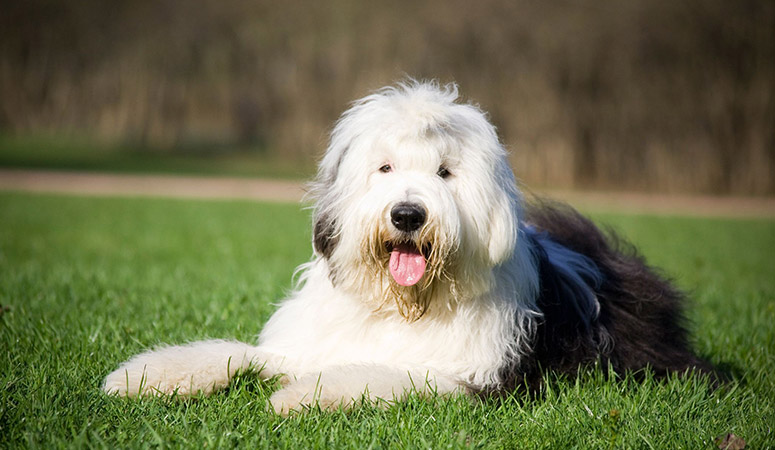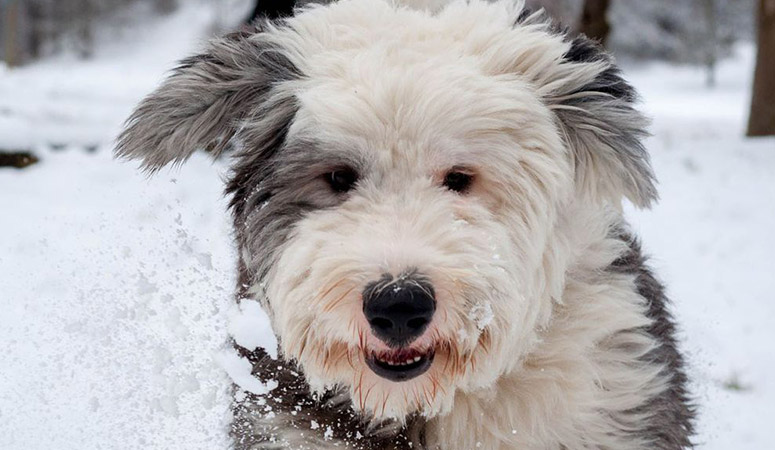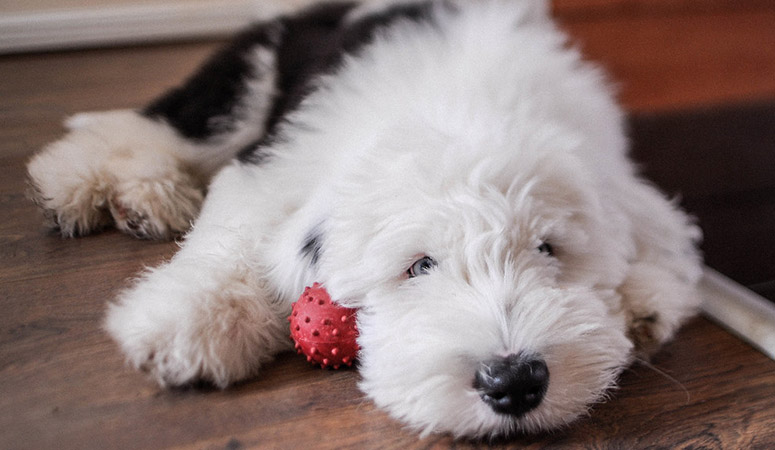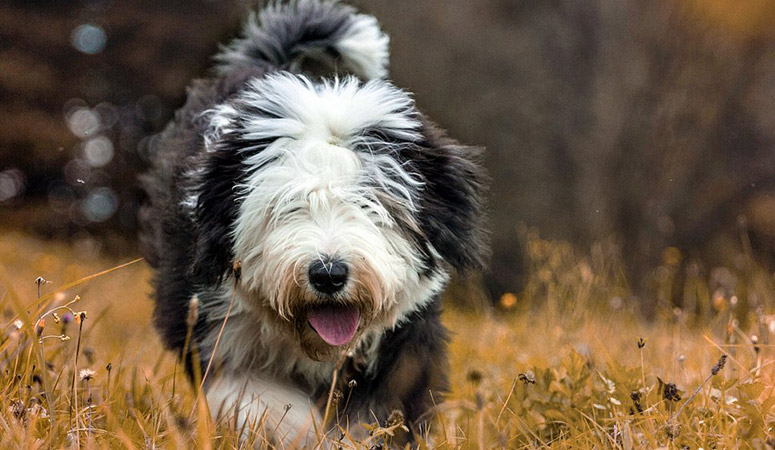Old English Sheepdog
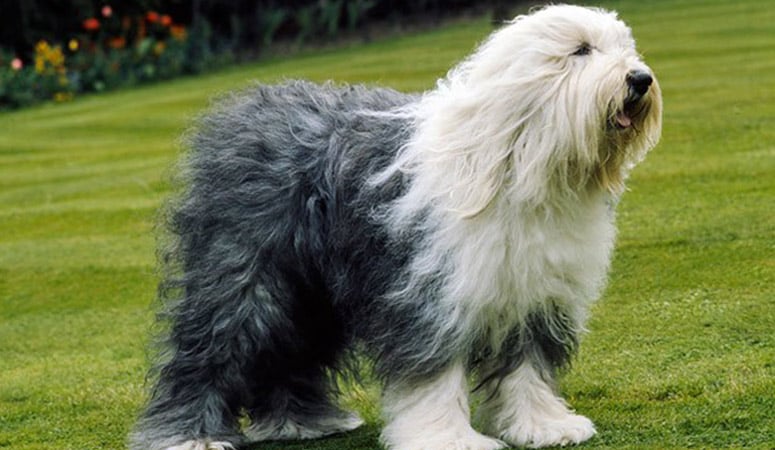
The Old English Sheepdog is a big, athletic dog breed with a profuse coat and peak-a-boo hairdo, the most distinguishing feature of him is the abundant, shaggy coat that hangs over his eyes. These dogs’ original job was cattle herding in England, but now they have become companion dogs beloved for their friendly, often easygoing personalities.
| Other Names | Bob, Bob Tail |
| Color | Any shade of grey, grizzle, black, blue, or blue merle, with optional white markings |
| Height | Males: 22-24 inches. Females: 21-22 inches. |
| Weight | Males: 60-100 pounds. Females: 60-100 pounds. |
| Life Span | 10-12 years |
| Personality | Adaptable, Gentle, Smart |
| Exercise | Regular Exercise |
| Origin |
| Popularity | #70 |
| Groom Needs | 2-3 Times a Week |
| Kids Friendly | No |
| Dog Friendly | Yes with supervision |
| Watch Dog | |
| Family Dog | Yes |
| Litter Size | 5-8 |
Old English Sheepdog Pictures
Old English Sheepdog Video
Introduction
The Old English Sheepdog is smart and independent, but as a pet, you are going to love their remarkable sense of humor and his antics – sheer entertainment! That being said, he is strong-willed and needs a firm hand to guide them on the right path. This gorgeous dog is around 22 inches at the shoulders and weight is about 90 pounds. He is not considered a guard dog, but he can get pretty protective, using his loud bark to warn against intruders. Some, if left to their own devices for too long, can become nuisance barkers though and will dig, bark, and chew stuff if they are not exercised or mentally challenged enough. In France, they call his bark “pot cass” which means to sound like a broken jar or a cracked bell! Or it sounds like two pots banging together! He has a thick double coat which requires plenty of grooming, at least 3-4 hours a week – be prepared to be committed Old English Sheepdog owners. He is a loving pet that needs plenty of interaction with the family. He walks much like a bear but, remember, a bear needs plenty of exercise!
Living with Old English Sheepdog
The Old English Sheepdog has a double coat that requires a thorough grooming down to the skin, over the entire dog, at least weekly to maintain their full coats. The owner needs to spend at least three to four hours a week grooming, as the dog’s coat is difficult to maintain. And the OES sheds heavily and needs daily brushing to remove dead hair and keep the coat free of tangles. Be sure that you brushing down to the base of the fur and it is helpful to prevent dense mats that may cause skin problems. If the hair around her mouth turns a yellow color from food or drooling, wash it with a gentle, dog-safe cleanser.
Besides brushing and combing out the coat, the OES needs bathing every six to eight weeks. In summer days, it is suggested to trim the hair short to prevent the dog from potentially dangerous overheating.
And don’t forget to clean your dog’s ears with a gentle, dog-friendly cleanser to prevent ear infections. Brush the teeth quit a few times a week to prevent gum disease, and trim the nails every month to prevent cracking.
The Old English Sheepdog requires some physical activity because of his working origins. A healthy Old English Sheepdog requires an hour or two of vigorous exercise every day, this could be in form of long walks or a good run or play session, and games and tricks could provide dog needed mental exercise.
Generally, the dog’s exercise needs should be different from their ages. Pups have a lot of energy that they may use it to destroy home if they are not occupied with proper activities. Instead, older dogs may prefer to lie on the couch and need encouragement to exercise.
Importantly, don’t take your dog for outdoor exercise in the hot weather days because the OES could overheat quickly and easily.
Generally, it is recommended to feed an Old English Sheepdog with two and a half to four and a half cups of high-quality dry dog food every day, divided into two meals. More importantly, the food amount should depend on the dog’s weight, size, age, and activity level. There should be fresh and clean water at all times.
Some dogs are easy to get overweight, so you need to watch their calorie consumption and weight level all the time. Treats may be an important aid in training, but excessive intake can lead to obesity. Also, owners need to distinguish which human food is safe for dogs and which are not. If you have any problems with your dog’s weight or diet, just consult from your veterinarian.
The Old English Sheepdogs are prone to the following health conditions: cataracts, deafness, retinal detachment, progressive retinal atrophy, hypothyroidism, gastric torsion, canine hip dysplasia, cerebellar abiotrophy, dilated cardiomyopathy, immune-mediated hemolytic anemia and thrombocytopenia, etc.
Major concerns: CHD
Minor concerns: otitis externa, gastric torsion, cataract, retinal detachment, deafness, PRA, hypothyroidism, cerebellar ataxia
Suggested tests:
EIC DNA Test
Thyroid Evaluation
Hip Evaluation
Ophthalmologist Evaluation
Total Annual Cost: $3239
Cost is estimated for the first year and may vary depending on many factors, such as dog food, health care, leash, collar, licensing, possible fencing, crates, training and obedience classes, dog-walking, grooming, treats, toys, flea, tick, and heart-worm meds, microchips, etc.
The Old English Sheepdogs are smart and they could learn basic commands with ease, but they may not pay attention in class. Patience and consistency are the keys when training the dog. Most Old English Sheepdogs are quite intelligent and have a biddable nature, they don’t forget what they have learned. But they tend to get bored with repetitive nature and robotic training exercises, and if you want to participate in some of those activities, you need to change things up and make it new and fun.
Besides, agility training and dog sports are a good way to keep your dog in good physical and mental conditions. The OES likes to stay with their people and the training could keep the dog mentally challenged.
History
He originates from the southwestern counties of England. His name might have the word ‘old’ in it but actually he hasn’t been around for thousands of years. Neither is he technically a sheepdog when you compare him to some ancient breeds – his breed is only a couple of hundred years old. In fact, the Scottish Bearded Collie is thought to have played a huge role in the development of the Old English Sheepdog. Others claim he was developed from the Russian Ovcharka. That seems possible if you look at this dog, doesn’t it!
In the 1880s, a man called William Wade – an industrialist from Pittsburgh – he promoted this breed to the point that in just 20 years, five of the richest families in the USA owned the Old English Sheepdog – these included the Vanderbilts and the Guggenheims.
Then there was Slumber, the Old English Sheepdog who won the “Best” category at the Westminster Kennel Club Dog Show in 1914, hands down. It was Slumber’s win that is credited with having promoted the popularity of the breed. The judge himself said Slumber came close to be the accepted model of perfection in any dog he had ever seen.
Did you know that singer Paul McCartney sang about his very own Old English Sheepdog in his song “Martha My Dear”?
He was registered with the AKC in 1888.
Helpful Information
Breed Club: OLD ENGLISH SHEEPDOG CLUB OF AMERICA, INC.
Breed Club Link: http://www.oldenglishsheepdogclubofamerica.org/
Breed Club Rescue:
Breed Club Rescue Link: https://oldenglishsheepdogclubofamerica.org/owning-an-oes/rescue/

